Accelerate Productivity in 2025
Reignite Growth Despite the Global Slowdown
Edge computing faces a variety of challenges related to data security and processing. In this article, we will delve into various trends in tackling these persistent challenges. They range from edge AI’s prowess in data processing to the connectivity breakthroughs brought by 5G and the Internet of Things (IoT). You also get to explore other key edge computing trends in 2024 like edge analytics, blockchain, and multi-access edge computing (MEC). For this research, we analyzed 1600+ emerging edge computing companies to identify the industry’s up-and-coming trends. Read more to explore how each trend advances business operations and 20 innovative startups in the field.
Innovation Map outlines the Top 10 Trends in Edge Computing & 20 Promising Startups
For this in-depth research on the Top Edge Computing Future Trends & Startups, we analyzed a sample of 1648 global startups & scaleups. This data-driven research provides innovation intelligence that helps you improve strategic decision-making by giving you an overview of emerging technologies in the computing industry. In the Edge Computing Innovation Map below, you get a comprehensive overview of the innovation trends & startups that impact your company.
These insights are derived by working with our Big Data & Artificial Intelligence-powered StartUs Insights Discovery Platform, covering 3 790 000+ startups & scaleups globally. As the world’s largest resource for data on emerging companies, the SaaS platform enables you to identify relevant technologies and industry trends quickly & exhaustively.
Tree Map reveals the Impact of the Top 10 Edge Computing Trends in 2024
Based on the Edge Computing Innovation Map, the Tree Map below illustrates the impact of the Top 10 Latest Edge Computing Trends in 2024. Edge AI brings computing to edge devices and enables faster, local data processing, also reducing latency. The advent of 5G offers ultra-high-speed, low-latency connectivity, vital for efficient communication between edge devices and central systems. IoT enhances interconnectivity and data exchange among devices, streamlining data collection and decision-making. Edge analytics provides real-time data analysis at the edge, resulting in real-time insights for critical operations. Blockchain ensures data integrity and security in edge environments while MEC eases network congestion by bringing cloud capabilities closer to the edge. Further, edge data centers offer localized storage and analysis and the IT/OT Convergence boosts overall operational efficiency. Fog computing, a related trend, also decentralizes computation and storage, bringing it closer to the data source.
Top 10 Trends in Edge Computing (2024)
- Edge AI
- 5G
- Internet of Things
- Edge Analytics
- Blockchain
- Multi-Access Edge Computing (MEC)
- Edge Data Centers
- IT/OT Convergence
- Data Security
- Fog Computing
Global Startup Heat Map covers 1648 Emerging Edge Computing Companies
The Global Startup Heat Map below highlights the global distribution of the 1648 exemplary startups & scaleups that we analyzed for this research. Created through the StartUs Insights Discovery Platform, the Heat Map reveals high startup activity in the US, followed by Western Europe and India. Below, you get to meet 20 out of these 1648 promising startups & scaleups as well as the solutions they develop. These edge computing startups are hand-picked based on criteria such as founding year, location, funding raised & more. Depending on your specific needs, your top picks might look entirely different.
Top 10 Latest Trends in Edge Computing (2024)
1. Edge AI
One of the key challenges AI solves is the ability to handle large amounts of data generated at the edge by deploying machine learning algorithms and other AI models. This promotes real-time data processing and analysis, lowering latency and bandwidth requirements. Additionally, AI algorithms enhance the efficiency and accuracy of data analysis, enabling quick insights and actionable intelligence at the edge. AI also enables intelligent decision-making by leveraging predictive analytics and pattern recognition, empowering edge devices to make autonomous and context-aware decisions. Moreover, AI-based anomaly detection and predictive maintenance increase the reliability and uptime of edge systems by identifying potential issues and facilitating proactive measures.
EDGENeural.ai develops an End-to-End Edge AI Platform
EDGENeural.ai is a US-based startup that offers an end-to-end edge AI platform. It enables AI developers to train, optimize, and deploy deep learning models quickly on any hardware. The platform emphasizes achieving the maximum accuracy-latency trade-off and high speed for machine learning models. It is a modular, unified, and hardware-agnostic software-defined platform that integrates the entire workflow for AI engineers working on various AI applications. The platform is user-friendly and does not require coding expertise, allowing companies to save costs on high-cost edge AI developers.
Tercero innovates FPGA-based Tactical Edge AI
Tercero is a US-based startup that specializes in advanced field programmable gate array (FPGA)-based software and hardware solutions for defense applications. With a focus on the tactical edge, the startup bridges the gap between AI research labs and real-world defense scenarios. Its FPGA-based technologies offer a more suitable solution for applications with significant size, weight, and power constraints (SWaP). The startup’s expertise spans various areas, including autonomous navigation and control of unmanned ground vehicles, perception, and sensor processing using state-of-the-art techniques. It also leverages open communication standards like ROS and JAUS, system architecture planning, as well as intellectual property strategy consulting. By leveraging FPGA-based solutions, the startup brings the power of AI to defense applications, enhancing maneuvering, perception, and overall system performance.
2. 5G
5G technology enhances edge computing by addressing the need for high-speed, low-latency connectivity between edge devices and centralized systems. With its ultra-fast data transmission speeds and low latency, 5G establishes seamless and real-time communication. This overcomes the concerns related to processing and analyzing large volumes of data generated at the edge. Additionally, 5G supports the deployment of bandwidth-intensive applications and services at the edge, reducing the burden on the centralized cloud infrastructure. As a result, 5G boosts network organization, lessens blockages and enables faster response times. Further, 5G’s high reliability and availability contribute to the resilience of edge computing systems, ensuring consistent connectivity and uninterrupted operations.
Rapid.Space builds an Open 5G Edge Cloud
Rapid.Space is a French startup that creates an open 5G edge cloud infrastructure for companies. The startup’s plug-and-play open radio station (ORS) is an autonomous base station for private 4G/5G edge-enabled networks. It is suitable for hybrid, autonomous, controlled, and managed operations that combine at the same site and at the same frequencies. The setup is eligible for converged networks that combine IoTs, controlled operation, and mobility, allowing companies to cut down operational costs.
FiduciaEdge Technologies offers a Network Platform for 5G Edge Computing
FiduciaEdge Technologies is a Taiwanese startup that provides software-based edge computing solutions prioritizing information security and user privacy. The startup’s solution enhances edge computing security and also protects user datasets and AI algorithms at the source. With its confidential edge computing approach, AI inferencing is performed within a secure environment without the need to expose raw data. This also eliminates the risk of data leakage. FiduciaEdge Technologies’ solution provides dedicated edge computing nodes that support real-time AI inference results while safeguarding the computing process from malicious hacking attempts.
3. Internet of Things
IoT ensures efficient interconnection and data exchange among numerous devices at the edge. By enabling strong communication and collaboration between edge devices, IoT facilitates data collection at the edge. This reduces the challenge of handling massive amounts of data generated by IoT items, ensuring timely and accurate analysis. Further, IoT enables edge devices to interact and respond to real-world events and conditions, supporting context-aware decision-making and enhancing overall system intelligence. IoT also allows for distributed computing and decentralized data processing, reducing the burden on centralized cloud infrastructure. Overall, IoT strengthens edge computing by enabling swift data exchange and improving scalability.
Creative Advanced Technologies deploys an Edge Platform for IoT Devices
UAE-based startup Creative Advanced Technology develops an IoT-ready business edge platform that automates application deployment, backup, and upgrades. It facilitates human resource management (HRM), customer relationship management (CRM), enterprise resource planning (ERP), and more. The platform features quick deployment and automatic updates, backups, and scaling-up, leading to controllable business continuity. It also supports various communication protocols for message transport between devices. The startup’s platform benefits businesses in sectors like logistics, healthcare, manufacturing, energy, smart cities, and agriculture, allowing them to focus on core business activities.
Venius develops an IoT Edge Computing Platform
Venius is a Swedish startup that offers a high-performance and intelligent IoT edge computing platform for smart offices. The platform’s accurate sensor technology detects real-time occupancy in various seating arrangements. It also utilizes edge analytics and machine learning to send only high-value data to the cloud, optimizing cost performance. The platform also ensures efficient wireless communication, minimizing infrastructure costs and simplifying installation processes.
4. Edge Analytics
By leveraging advanced analytics techniques, such as real-time stream processing and intelligent clustering, edge data analytics produces comprehensive findings on the edge items of interest. This overcomes the obstacles of latency and bandwidth by processing and analyzing data locally, eliminating the need for lengthy data transmission. Additionally, edge analytics programs enhance decision-making capabilities by providing contextual insights and motivating proactive measures. Further, data analytics allows organizations to optimize resource utilization and improve operational efficiency by identifying patterns, anomalies, and optimization opportunities.
Blockalytics offers Federated Edge Analytics
Blockalytics is a US-based startup that provides federated industrial analytics solutions for IoT edge applications. The startup’s platform generates insights from disparate data silos without the need for data relocation. This approach simplifies the analytics pipeline, decreases cloud costs, and aids data ownership verification while providing beneficial analytical insights. By eradicating the reliance on the cloud or central servers, Blockalytics minimizes latency and maintains data integrity. The platform is deployable for various analytics use cases in manufacturing, power, and oil and gas industries.
FedML builds an Edge AI Platform
FedML is a US-based startup that develops a decentralized and collaborative AI-driven platform that provides both an open-source community solution and an enterprise product. The platform allows businesses to train, deploy, monitor, and improve machine learning models, whether on the edge or in the cloud. By employing collaboration on combined data, models, and computing resources, it supports federated learning and decentralized on-device training. It also offers a unified and scalable distributed computing framework. FedML maintains industrial solutions tailored for multi-cloud environments, generative AI, mobility, and autonomous driving.
5. Blockchain
Blockchain technology ensures data integrity, immutability, and security in distributed edge environments. By leveraging its decentralized and transparent nature, blockchain provides a trusted and tamper-proof mechanism for recording and verifying transactions and data exchanges. This lowers concerns related to trust, data counterfeiting, and unauthorized access. Additionally, blockchain enables secure data sharing and collaboration among edge devices, facilitating reliable interactions. Blockchain’s consensus algorithms further ensure agreement and synchronization of data across multiple edge nodes, promoting data consistency and reliability. Blockchain enhances data governance and privacy by allowing businesses to control their own data and providing mechanisms for selective data disclosure on the edge.
Atkrypto.io runs Blockchain on the Edge
Atkrypto.io is a Czech startup that builds a distributed ledger technology that runs on smartphones, mobile devices, edge devices, and IoT devices. It focuses on ensuring data protection, privacy, and safety at the edge and IoT. The platform advances Web 3.0 by allowing any device to run peer-to-peer (P2P) private blockchains and tokenizing assets anywhere. Atkrypto.io’s proprietary blockchain software also facilitates asset digitization and tokenization on private blockchains and provides a dedicated blockchain wallet. The platform caters to various sectors, including IoT, communications, application developers, and individuals. This enables functionalities like secured communications, decentralized app (dApp) development, and trading collectibles.
StrongNode Edge builds Green Edge Infrastructure
StrongNode Edge is a Japanese startup that provides blockchain infrastructure-as-a-service (IaaS). The startup’s product is an IaaS protocol that applies idle computing power from devices like mobile phones and home appliances for faster, more reliable, and greener computing. By connecting device owners with service providers through proprietary tokens, StrongNode Edge encourages users to monetize their idle resources. It offers a cost-effective, energy-efficient alternative to traditional data centers. The platform also fosters decentralized economies, empowering users to participate and create new opportunities in edge computing. In addition, StrongNode Edge prioritizes interoperability and supports multiple blockchain networks. With user-friendly implementation and flexible payment schemes, businesses gain a competitive edge by deploying applications and services closer to their customers.

6. Multi-Access Edge Computing
Multi-access edge computing enhances edge computing architecture by deploying cloud computing resources closer to the edge devices. This results in faster data processing and increased convenience. As a result, MEC allows businesses to overcome the obstacles of transmitting large volumes of data to remote cloud servers, reducing network jams and improving response times. Further, it enables edge devices to utilize cloud services and applications directly, as well as facilitates the deployment of real-time and context-aware applications in time-sensitive scenarios. Therefore, MEC lowers the dependency on centralized cloud infrastructure by improving the resilience and availability of edge computing systems.
Sma-RTy Edge Technology delivers MEC-based Computation Offloading
Sma-RTy Edge Technology is an Italian startup that leverages MEC to fulfill the requirements of the 5G infrastructure and migrate corresponding services to the edge. In a mobility-related project, the startup collaborated with 5G experts to offload vehicular computation using MEC. This demonstration highlights potential applications of MEC like in distributed ledger technologies (DLT).
Nife Labs enables Accelerated App Deployment
Nife Labs is a Singaporean startup that offers an edge application platform to simplify 5G, edge computing, and cloud complexities. The solution redefines cloud computing with multi-access edge computing. The startup’s Nife Edge Grid allows enterprises and developers to quickly launch applications with security, privacy, and reduced costs. With a suite of APIs and tools, businesses build, manage, deploy, and scale applications across hybrid cloud infrastructure. The platform also leverages idle resources and offers a decentralized ecosystem, enabling accelerated app deployments and improved efficiency. It thus provides on-demand resources, smooth app deployment, and global scalability.
7. Edge Data Centers
By deploying data centers closer to the edge devices, businesses are able to move data storage, processing, and analysis closer to where the data is generated. This enables efficient scaling and allows for distributed computational and storage resources across multiple locations, reducing the strain on centralized data centers. Additionally, edge data centers provide the necessary computational resources and storage capacity to handle massive datasets. This, in turn, magnifies the functionality and performance of edge computing systems. Further, edge data centers enhance data privacy and security by diminishing the exposure of sensitive information to external networks. By bringing computing capabilities closer to the edge, data centers improve the reliability and resilience of edge systems. This ensures consistent operations even in the event of random network disruptions.
Edge Centres builds Solar-powered Edge Centers
Edge Centres is an Australian startup that develops solar-powered edge data center facilities. The startup offers global connectivity through its dedicated backbone and cable landing stations, catering to various market needs. Edge Centres builds modular and sustainable edge pods across APAC, North America, and beyond. These facilities provide ultra-low-latency connectivity and computing resources close to end users. Each facility is equipped with reliable power (200KVA), efficient cooling, and robust security measures.
EdgeX provides Resilient Data Centre Facilities for Edge Computing
EdgeX is a US-based startup that makes resilient data facilities to extend the edge and mitigate latency. The startup’s target industries include financial services, digital content distribution, insurance, and enterprise applications that require high uptime as well as scalable computing, storage, and content distribution. By locating edge data centers in underserved markets, EdgeX improves the customer experience by providing faster interactions with content.
8. IT/OT Convergence
The convergence of information technology (IT) and operational technology (OT) improves the integration and collaboration of otherwise traditionally separate domains. This enables consistent communication and data exchange between edge devices and backend systems. Moreover, integrated IT/OT systems eradicate disjointed and siloed operations by establishing efficient coordination and information flows. IT/OT convergence also aids unified management and control of both IT and OT infrastructure, leading to improved operational efficiency and resource optimization. It empowers advanced analytics, real-time monitoring, and predictive maintenance at the edge, enhancing the reliability and performance of edge computing systems. As a result, IT/OT merger promotes standardized protocols and interoperability across devices.
MaestroHub offers a Single Source of Truth (SSoT) for Manufacturing
MaestroHub is a Turkish startup that delivers a single source of truth for manufacturing companies. It connects IT and OT data from systems for warehouse management, quality management, ERP, sensors, manufacturing execution systems (MES), and more. Additionally, the platform leverages edge computing to speed data transfer and analysis. Using this approach, the startup’s data governance platform enables real-time data preparation, sharing information to multiple endpoints, and generating operational insights. It benefits textile, food, and automotive manufacturing.
Perygee improves IT/OT Security
Perygee is a US-based startup that offers a cybersecurity platform that enhances the operational efficiency of IOT and OT devices. The graph-based data platform unifies the data in one place to protect the organization’s assets. It is easy to deploy and customize, a no-code tool that allows users to build dashboards and workflows with ease. Perygee offers a holistic security solution to organizations by ensuring continuous compliance through automated evidence collection, real-time checks, and data consolidation. This allows businesses to meet compliance with common data security standards.
9. Data Security
Data security trend evolves around the protection of sensitive edge data from unauthorized access, tampering, and breaches. By implementing robust encryption, authentication, and access control mechanisms, data security programs ensure the confidentiality, integrity, and availability of data. This mitigates concerns related to data privacy and compliance in distributed edge environments. Similarly, data security measures minimize the risks of cyber-attacks, safeguarding critical information and systems. In conclusion, advances in data security allow edge professionals to better manage the evolving threat landscape and ensure ongoing protection for edge systems.
Sitehop offers FPGA Hardware-enforced Cybersecurity
Sitehop is a UK-based startup that develops cybersecurity solutions. The startup’s FPGA hardware-enforced cybersecurity suite, Sitehop SAFE, is a user-friendly device that is added at the network edge to provide a low encryption latency. The user data is bypassed by software using specially built hardware devices on a single chip, reducing the possibility of software-based breaches. Additionally, the hardware connection is tightly controlled by the device, resulting in a low attack profile and shorter latency. The solution improves data security for sectors such as government organizations, transportation, data centers, and more.
Primary Guard provides Advanced Edge Cybersecurity
Primary Guard is a Malaysian startup that offers solutions for edge cybersecurity to minimize the impact of cyberattacks and maintain essential business functions. The startup’s intelligent DDoS protection solution offers protection from a variety of attack vectors and prevents system downtimes. Primary Guard also offers zero-trust network access and business endpoint protection products to detect, analyze, and block cyberattacks.
10. Fog Computing
Fog computing systems process data in a decentralized manner and perform computations locally, near the source of data generation. This reduces latency and bandwidth requirements. By distributing computing resources in a hierarchical manner, fog computing improves the efficiency and scalability of edge computing systems. It enables real-time data analysis, decision-making, and response, allowing for faster insights and actions. Additionally, fog computing enhances system reliability by reducing dependency on more centralized cloud infrastructure, ensuring continuous operations even in the event of network disruptions. Fog computing further improves data privacy and security by minimizing the need to transmit sensitive data to external cloud servers.
Drofika develops an AI-powered Fog Computing Platform
Drofika is a Turkish startup that creates an AI-powered fog computing platform that streams data to generate insights at the edge. By bringing cloud-like functionality closer to data sources and integrating real-time capabilities, the startup combines IT and OT into a single platform. Deployed at the edge, fog nodes offer managed and scalable networking, computing, and storage resources. The Fog System Manager facilitates device deployment and provisioning, while Drofika’s software supports real-time software-defined networking, computing, data management, and analytics. With a focus on both IT and OT domains, Drofika ensures comprehensive defense through network segmentation, hardware root of trust, and data encryption.
Datasance offers an Edge Intelligence Platform
Datasance is a US-based startup that provides enterprises with an open-source distributed edge intelligence platform – Datasance PoT. It features fog computing capabilities that create peer-to-peer connectivity at the edge layer. The platform brings compute, storage, network, control, and decision mechanisms to the edge layer. Further, it enables distributed autonomous decision-making between edge devices. Key features include a Layer 7 encrypted mesh network using Skupper, semantic peer-to-peer edge connectivity, automatic quarantine of rogue nodes, precise control over data flow, and more.
Discover all Edge Computing Trends, Technologies & Startups
With advances in powerful processors like multi-core CPUs and specialized accelerators, edge devices increasingly handle complex computational tasks locally. Moreover, the proliferation of 5G networks enables faster and more reliable data transmission, facilitating real-time processing and analysis at the edge. These advancements will improve latency, scalability, privacy, and overall system performance, ushering in a new era of decentralized and intelligent edge computing solutions. The trends in edge computing & startups outlined in this report only scratch the surface of trends that we identified during our data-driven innovation & startup scouting process. Identifying new opportunities & emerging technologies to implement into your business goes a long way in gaining a competitive advantage.




![Future of Robotics: 12 Trends Powering the Next Wave [2025-2030]](https://www.startus-insights.com/wp-content/uploads/2025/06/Future-of-Robotics-SharedImg-StartUs-Insights-noresize-420x236.webp)





